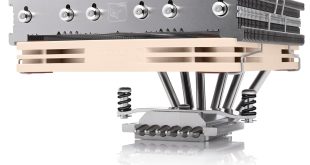For our AMD install we need to ensure that the backplate is mounted in the right direction. This information is engraved in the backplate, so it isn't complicated. Once the correct orientation is selected, the black plastic spacer should be placed on top of the backplate, then snapped into position. Finally we remove the protective layer and attach the 4 insulating pads to the backplate.
Now we place the backplate in the mounting spot and slide the 4 long screws through the holes in our motherboard. Once the screws are inserted the next step is to place the 4 black plastic pillars over the 4 screws, to hold it all in place.
After joining the Intel and AMD retaining brackets it is secured using 4 silver nuts. It is important to ensure the arrows that are engraved on the 2 Intel brackets are pointing inward towards the CPU. After applying the thermal paste we can then place the cooler on the processor and secure it using the brace that rests on the base of the cooler. This attaches to the 2 threaded posts on the AMD retention bracket.
The fans on the Havik 120 use the same rubber mounting devices that were used on the Havik 140 and they make installation a breeze. After attaching the desired number of fans all that is left is to attach the fans to a header on the motherboard.
NZXT have provided 2 Y split cables to make attaching the dual fans a simple process. The cable with the black headers provides the full fan speed, while the cable with the white headers limits fan speed to 1,500 RPM on our review sample..
We installed the Havik 120 in the new Tempest 410 Elite first and then we moved it into our test system. There were no issues with either install but the larger roomy Phantom made the installation even easier.
 KitGuru KitGuru.net – Tech News | Hardware News | Hardware Reviews | IOS | Mobile | Gaming | Graphics Cards
KitGuru KitGuru.net – Tech News | Hardware News | Hardware Reviews | IOS | Mobile | Gaming | Graphics Cards












